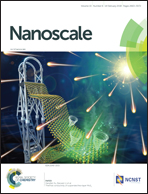Anomalous thermoelectricity of pure ZnO from 3D continuous ultrathin nanoshell structures†
Abstract
ZnO is a potential thermoelectric material because of its non-toxicity, high thermal stability, and relatively high Seebeck coefficient (S) of metal oxides. However, the extremely low figure of merit (zT), which comes from a high thermal conductivity (κ) over 40 W m−1 K−1, limits the thermoelectric application of ZnO. In particular, below 500 K, ZnO exhibits a nearly negligible zT (<10−3), unless a dopant is incorporated into the crystal structure. Here, we propose a new strategy for achieving a reduced κ and a correspondingly increased zT of pure ZnO over a wide temperature range from 333 K to 723 K by forming an ∼72 nm thick, 3D continuous ultrathin nanoshell structure. The suppressed κ of the 3D ZnO film is ∼3.6 W m−1 K−1 at 333 K, which is ∼38 times lower than that of the blanket ZnO film (3.2 μm thick), which was set as a reference. The experimental zT of the 3D ZnO film is ∼0.017 at 333 K, which is the highest value among pure ZnO reported to date and is estimated to increase by ∼0.072 at 693 K according to the Debye–Callaway approach. Large-area (∼1 in2) fabrication of the 3D ZnO film with high structural uniformity allows the realization of an integrated thermoelectric device, which generates ∼60 mV at a temperature difference of 40 K along the in-plane direction.



 Please wait while we load your content...
Please wait while we load your content...